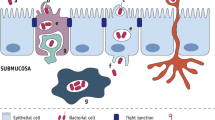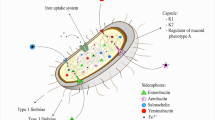Abstract
ETEC isolates from various sources (children from Ethiopia and some Asian countries, and Swedish tourists suffering from traveller's disease) were analysed with the aid of “biochemical fingerprinting”, which is a highly discriminative, computerized method designed to subdivideE. coli isolates into different phenotypes. Isolates belonging to the most common ETEC O-groups and others which had not been typeable with available O-antisera were selected. It was found that certain phenotypes of O-groups 6 and 114 could be found in materials from several continents. Phenotypes of other O-groups were usually more restricted to certain geographic areas. Among children in Addis Abeba, 19 out of 25 isolates carrying O-antigen 78 belonged to the same phenotype. Some possible explanations for the fact that certain phenotypes of enterotoxigenicE. coli could be found over the whole world are that they might represent relatively recent developed clones, or they may represent unusually stable clones. Of the isolates that had been nontypeable with available antisera, some had lost their LT-productivity after one year of storage. These isolates proved to belong to a wide variety of phenotypes, whereas nontypeable isolates which were stable LT-producers could be clustered into distinct groups. It is suggested that the non-stable LT-producers are members of the normalE. coli flora of these children, which have occasionally picked up the enterotoxin-producing plasmids, whereas most stable LT-producers represent true ETEC clones.
Similar content being viewed by others
References
Achtman M, Mercer A, Kusecek B, Pohl A, Heuzenroeder M, Aaronson W, Sutton A, Silver RP (1983) Six widespread bacterial clones amongEscherichia coli K1 isolates. Inf Immun 39(1):315–335
Bäck E, Blomberg S, Wadström T (1977) EnterotoxigenicE. coli in Sweden. Infection 5(1):2–5
Bäck E, Möllby R, Kaijser B, Stintzing G, Wadström T, Habte D (1980) EnterotoxigenicE. coli and other Gramnegative bacteria of infantile diarrhoea: Surface antigens, Hemaglutinins, colonization factor antigens and loss of enterotoxigenicity. J Infect Dis 142:318–327
Crichton RP, Old DC (1982) A biotyping scheme for the subspecific discrimination ofEscherichia coli. J Med Microbiol 15:233–241
Edwards RP, Ewing WH (1972) Identification of Enterobacteriaceae. 3rd edition. Burgess Publishing Company
Evans DJ, Evans DG, DuPont HL, Ørskov F, Ørskov I (1977) Patterns of loss of enterotoxigenicity byE. coli isolated from adults with diarrhoea: suggestive evidence for interrelationship with serotype. Infect Immun 17:105–111
Gargan R, Brumfitt W, Hamilton-Miller JMT (1982) A concise biotyping system for differentiating strains ofEscherichia coli. J Clin Patol 35:1366–1369
Gianella RA (1976) Suckling mouse model for detection of heat-stableE. coli enterotoxin: characteristics of the model. Infect Immun 14:95–99
Gross RJ (1983)Escherichia coli diarrhoea. J Infect 7:177–192
Kaijser B (1977) A simple method for typing of acidic polysaccharide K antigens ofE. coli. Federation of European Microbiology Societeies: Microbiology Letters 1:285–288
Kühn I (1985) Biochemical fingerprinting ofEscherichia coli. A simple method for epidemiological investigations. J Microbiol Methods 3:159–170
Kühn I, Franklin A, Söderlind O, Möllby R (1985) Phenotypical variations among enterotoxigenicE. coli from Swedish piglets with diarrhoea during 1964–1984. Med Microbiol Immunol 174:119–130
Lidin-Jansson G, Falsen E, Jodal U, Kaijser B, Lincoln K (1977) Characteristics of antibiotic resistantE. coli in the rectum of healthy schoolchildren. J Med Microbiol 10:299–308
Mohapatra LN, Samantaray JC, Deb M, Stintzing G, Möllby R, Holme T (1984) Comparative evaluation of GM1-ELISA and tissue culture assays for detection of thermolabile enterotoxin (LT) ofEscherichia coli. Indian J Med Res 79:733–740
Möllby R, Bäck E (1981) Bacterial and Parasitic Agents in Acute Diarrheal Disease in Sweden. In: T. Holme, J. Holmgren, M.H. Merson and R. Möllby (eds) Acute Enteric Infections in Children. New Prospects for Treatment and Prevention. Elsevier Biochemical Press, Amsterdam
Ørskov F, Ørskov I (1983) Summary of workshop on the clone concept in the epidemiology, taxonomy, and evolution of the Enterobacteriaceae and other bacteria. J Infect Dis 148(2): 346–357
Ørskov F, Ørskov I, Evans DJ, Sack RB, Sack DA, Wadström T (1976) SpecialE. coli serotypes among Enterotoxigenic strains from diarrhoea in adults and children. Med Microbiol Immunol 162:73–80
Ørskov I, Ørskov F (1977) Special O∶H∶K serotypes among enterotoxigenicEscherichia coli strains from diarrhoea in adults and children. Med Microbiol Immunol 163:99–110
Sack DA, Sack RB (1975) Test for enterotoxigenicE. coli using Y1 adrenal cells in miniculture. Infect Immun 11:334–336
Sanderson KE (1976) Genetic relatedness in the family Enterobacteriaceae. Ann Rev Microbiol 30:327–349
Sneath PHA, Sokal RR (1973) Numerial Taxonomy. W.H. Freeman and Company, San Francisco
Stintzing G, Bäck E, Tufvesson B, Johnsson T, Wadström T, Habte D (1981) Seasonal fluctuations in the occurrence of enterotoxigenic bacteria and rotavirus in pediatric diarrhoea in Addis Ababa. Bull World Health Org 59:67–73
Stoll BJ, Rowe B, Glass RI, Gross RJ, Imdadul H (1983) Changes in serotypes of enterotoxigenicEscherichia coli in Dhaka over time: Usefulness of polyvalent antisera. J Clin Microbiol 18(4):935–937
Author information
Authors and Affiliations
Rights and permissions
About this article
Cite this article
Kühn, I., Möllby, R. Phenotypic variations among enterotoxigenic O-groups ofEscherichia coli from various human populations. Med Microbiol Immunol 175, 15–26 (1986). https://doi.org/10.1007/BF02123125
Received:
Issue Date:
DOI: https://doi.org/10.1007/BF02123125




